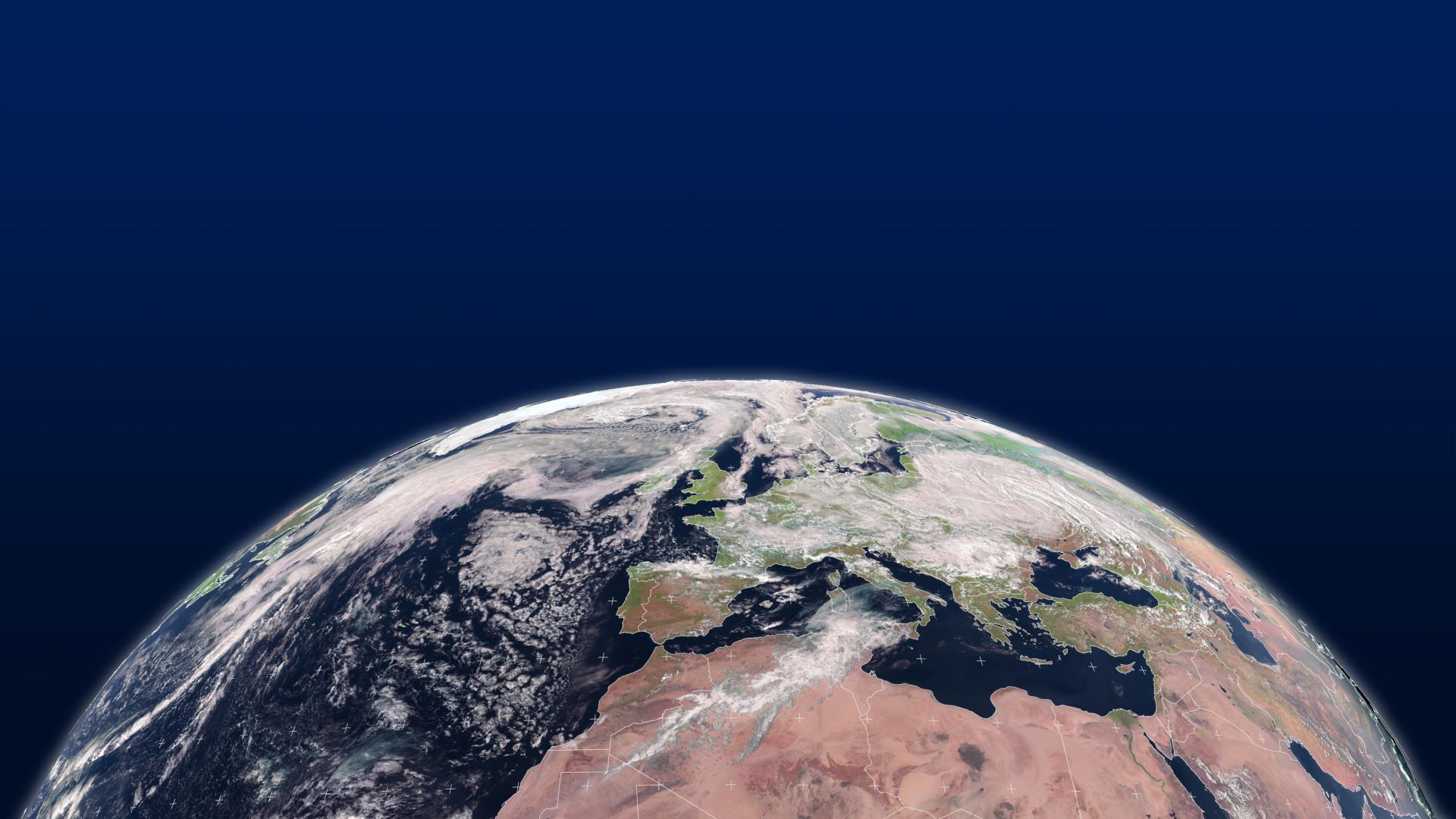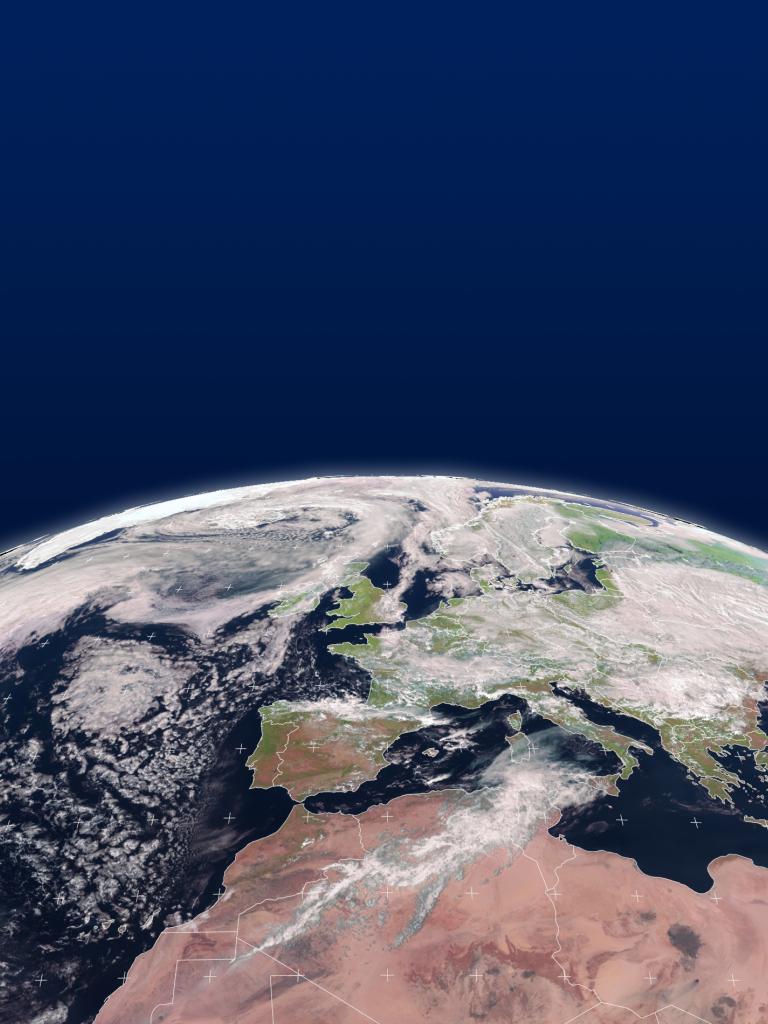
Forecasting extreme weather now and in the future
As Romania prepares to host the 2021 EUMETSAT Meteorological Satellite Conference, we catch up with the team at the National Meteorological Administration (NMA).


The virtual 2021 EUMETSAT Meteorological Satellite Conference takes place this week, jointly hosted and organised by the National Meteorological Administration of Romania (NMA). We catch up with NMA team members to discuss progress and priorities for improving predictions for weather forecasting and responding to climate change.
01 November 2023
21 September 2021
Thanks to powerful tools and products that pool together near-real time data on aspects such as rainfall, ground saturation, and humidity, short-term forecasts for extreme weather events are more accurate and timely than ever before. Yet in some ways forecasting them is getting harder.
“Climate change makes severe weather events more likely, while economic and social activities that rely on short-term weather forecasts are also increasing,” says Elena Mateescu, Director General of Romania’s National Meteorological Administration (NMA), which is a member of EUMETSAT’s Nowcasting Satellite Application Facility (NWC SAF). “Next-generation satellites bring great opportunities to further improve short-term forecasting, but at the same time there will also be a huge increase in data volume provided by the observations made by these satellites. Therefore, the development of ground communication systems and products that can effectively and efficiently sift through these data to produce accurate nowcasts is a very high priority.”
The power of short-term forecasts
Nowcasts are short-range forecasts that involve mapping current weather, estimating the speed and movement of weather patterns, and using this information to predict what conditions will be like in the very near future. “They are one of the most important methods that forecasters use to predict the location and timing of potentially deadly weather events,” says Mateescu. “Nowcasting can give forecasters a window of opportunity to get warnings out about thunderstorms, flooding, windstorms, and other phenomena linked to convective conditions – and hopefully reduce the impacts of such catastrophic events.”
In the past five years, Romania has experienced a highly unusual variability in rainfall, according to Mateescu, who has worked at the Bucharest-based organisation for more than three decades. “Nowcasting has led forecasters to issue many more code red warnings – the highest level – than in the recent past. In 2019, there were only 76, while in 2020 the number increased to 160, and, so far in 2021, more than 220 have been issued,” she explains. “For example, in June this year some parts of Romania saw more than 100 millimetres of rainfall in less than one hour, causing extensive damage. Multiple warnings were issued for flash-flooding, heavy precipitation and wind storms.”
In order to deliver warnings for such dangerous events, forecasters at the NMA work around the clock to analyse data from a wide range of different sources. These include weather stations, radars, and numerical weather models that experts can draw on to spot fast-changing weather patterns. Underpinning their work are observations from meteorological satellites such as the Copernicus Sentinel series, and the Metop and Meteosat Second Generation series, which can provide a wide range of information on aspects such as the rates and intensity of rainfall, or the likelihood of fog or severe winds developing.
To make sense of this data as quickly as possible, forecasters turn to nowcasting products such as those developed by EUMETSAT’s Nowcasting Satellite Application Facility (NWC SAF). Such products support complex processes of receiving, processing, visualising, disseminating, and archiving data from meteorological and atmospheric surveillance satellites. “One of the greatest challenges we face as forecasters is to issue weather warnings in a timely enough manner for authorities to be able to react,” says Gabriela Băncilă, Director for Operational Meteorology at the NMA.
“A related challenge is to increase the precision of warnings regarding the location, intensity, and duration of potentially hazardous phenomena,” explains Băncilă. “For example, nowcasting products can provide users with a wide range of parameters on convection events and how they will develop, or provide rainfall rates from multiple spectral channels. It can help us to integrate data into severe weather indices or produce composite images that can help us to spot fast moving events such as thunderstorms, severe winds, or fog.”
Next-generation forecasting
Forecasts making use of meteorological satellite observations have come a long way since the NMA’s Institute for Meteorology established its first Satellite Meteorology Laboratory in 1969. A year later, operational activities provided forecasters with images from NOAA satellites, data that was received using a single Hawker Siddeley satellite station donated by the World Meteorological Organization (WMO). “Forecasters needed to hand-draw nephanalyses – synoptic charts of cloud types and precipitation – from satellite pictures on photographic paper to make predictions,” says Andrei Diamandi, a Senior Researcher in the Remote Sensing and Satellite Meteorology Laboratory at the NMA. “Today, thanks to the evolution of meteorological satellites and computer technologies, we benefit from fully automated product generation, for instance from Meteosat Second Generation, the Metop series, and NOAA satellite systems.”
The NMA operates a EUMETCast station and satellite processing system, which provides real-time satellite imagery and products to the National Weather Forecasting Centre and regional centres. “The software of the Nowcasting SAF is used to compute locally products and distribute them to forecasters,” says Diamandi. “Information provided by weather satellites has become so useful and integrated into the process of forecasting that it’s unthinkable to do without it.”
To support these activities, the NMA strives to continuously upgrade its national networks of automated weather station radars, communication systems, and lightning detectors. For instance, the organisation recently led a project contributing to a EU-funded Large Infrastructure Operational Programme aimed at promoting climate change adaptation, risk prevention, and management. One aspect involved developing a system for receiving, processing, archiving, and disseminating data from Copernicus Sentinel satellites to monitor areas affected by disasters or crisis situations such as flooding or drought.
Romania will also host a new WMO Regional Agrometeorological Centre for RAVI-Europe. The Centre is expected to start operations in 2023, with the goal of supporting sustainable agricultural production and implementing research programmes oriented towards mitigating climate change effects on agriculture. Mateescu points out that the work to be carried out at the centre, which will be underpinned by meteorological satellite data, will also help to strengthen international collaboration, enhance capacity building, facilitate beneficial partnerships, and promote professional training support activities.
And there is much more to come. In 2017, the NMA joined EUMETSAT’s NWC SAF consortium. The NMA is responsible for the development of software products able to process data from the forthcoming Meteosat Third Generation (MTG) Lightning Imager. It will become operational with the first satellite in series, MTG-I, which will be launched at the end of 2022, providing continuous monitoring of both intra-cloud and cloud-to-ground lightning strikes. “This will be the first time lightning imaging technology has been fixed to geostationary satellites over Europe,” Mateescu explains. “The products that we are developing will be particularly useful in informing nowcasting forecasts. Lightning patterns, for instance, can provide clues as to how storms may develop in the near future. We are very proud to be on the NWC SAF project team and we cannot wait to use the MTG Lightning Imager: the data it will provide could help save lives and livelihoods.”
Future opportunities
EUMETSAT'S SAF network, whose programmatic and funding framework for the 2022-2027 period has recently been approved, enables Member States to participate in the development, generation and delivery of data, software and information products as expert entities, based on their shared needs. Services are developed in a way that is beneficial for the entire community. The NMA also participates in other collaborative initiatives together with EUMETSAT from the delivery of agrometeorological training initiatives to hosting this year’s EUMETSAT Meteorological Conference.
“The conference will be a fantastic opportunity to learn, network and find potential project collaborators,” Mateescu says. “At the same time it presents a superb way of bringing people together to share ideas, innovate, and work together on the challenges ahead. From this perspective, the future means a greater collaboration between EUMETSAT and National Meteorological Services. There is great potential here and the success of the SAFs is proving it.”
As an example, Mateescu points to the European Weather Cloud, a distributed cloud computing infrastructure initiative by EUMETSAT and ECMWF that is currently in its pilot phase. It is anticipated that the technology will diversify the computing capabilities of Member States and make it easier for forecasters to combine satellite data from different instruments or payloads to improve their ability to detect local storms or fog, for instance that forms near essential facilities such as airports. “It will also be a key tool for fostering collaboration between Member States and EUMETSAT,” Mateescu says.
“With the launch of the Meteosat Third Generation and Metop Second Generation satellites, the already huge amount of sensor data and products available to forecasters will become even larger. For the Meteosat Third Generation Lightning Imager alone, it is thought there will be a 20-fold increase in raw data compared with Meteosat Second Generation, while the time that forecasters have to analyse and integrate all the available meteorological information and make decisions about whether to issue a severe weather warning is decreasing as a result of a growing number of climate change-related dangerous weather events.
“One answer to this challenge is to integrate all these meteorological data no matter their source in new, fewer products and tools. Here, Artificial Intelligence (AI) could play an important role and help forecasters to navigate the ever increasing data on severe weather events. I hope the EUMETSAT Meteorological Conference will stimulate such discussions and many more, so that we can make best use these amazing technologies to support societies and economies across Europe and help us to better predict, adapt, and react to global climate change.”